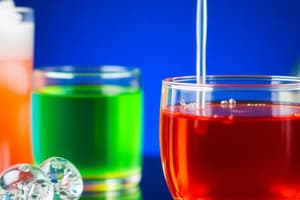Podcast
Questions and Answers
Which statement correctly describes a solid?
Which statement correctly describes a solid?
- It has a definite shape but no fixed volume.
- Its particles are loosely packed and can slide past each other.
- It occupies the entire volume of its container with free-moving particles.
- It has a definite shape and volume with tightly packed particles. (correct)
What is the main feature of gases?
What is the main feature of gases?
- They have a fixed shape and volume.
- They exhibit strong intermolecular forces between particles.
- Their particles move slowly and are closely packed.
- They fill the entire volume of their container and can be compressed. (correct)
Which type of solid is held together by ionic bonds?
Which type of solid is held together by ionic bonds?
- Iron
- Candle wax
- Diamond
- Sodium chloride (correct)
What is an example of a molecular solid?
What is an example of a molecular solid?
Which characteristic applies to liquids?
Which characteristic applies to liquids?
What distinguishes plasma from other states of matter?
What distinguishes plasma from other states of matter?
Which phase of matter has the highest kinetic energy?
Which phase of matter has the highest kinetic energy?
Which property is NOT characteristic of liquids?
Which property is NOT characteristic of liquids?
What is Bose-Einstein condensate?
What is Bose-Einstein condensate?
What occurs during the process of boiling?
What occurs during the process of boiling?
Which of the following represents a physical change?
Which of the following represents a physical change?
Which statement accurately distinguishes a chemical change from a physical change?
Which statement accurately distinguishes a chemical change from a physical change?
What is the main characteristic of fermionic condensates?
What is the main characteristic of fermionic condensates?
What defines a molecule?
What defines a molecule?
Which type of bond involves the sharing of electrons?
Which type of bond involves the sharing of electrons?
What does sublimation refer to?
What does sublimation refer to?
Which of the following properties is NOT a physical property?
Which of the following properties is NOT a physical property?
What does the atomic number represent?
What does the atomic number represent?
Which of the following is a sign of a chemical change?
Which of the following is a sign of a chemical change?
An example of a molecule is:
An example of a molecule is:
Which of the following is NOT a subatomic particle?
Which of the following is NOT a subatomic particle?
What role do molecules play in biological processes?
What role do molecules play in biological processes?
Which statement about the periodic table is accurate?
Which statement about the periodic table is accurate?
What happens to electrons during ionic bonding?
What happens to electrons during ionic bonding?
Flashcards
Atom
Atom
The smallest possible unit of an element that retains its chemical properties. It's the building block for all matter!
Element
Element
A pure substance made up of only one type of atom. It cannot be broken down into simpler substances by chemical means.
Solid
Solid
A state of matter where particles are tightly packed, giving it a definite shape and volume. Think of a solid block of ice.
Liquid
Liquid
Signup and view all the flashcards
Gas
Gas
Signup and view all the flashcards
Plasma
Plasma
Signup and view all the flashcards
Metallic solid
Metallic solid
Signup and view all the flashcards
Ionic solid
Ionic solid
Signup and view all the flashcards
Molecule
Molecule
Signup and view all the flashcards
Covalent Bond
Covalent Bond
Signup and view all the flashcards
Ionic Bond
Ionic Bond
Signup and view all the flashcards
Nucleus
Nucleus
Signup and view all the flashcards
Electrons
Electrons
Signup and view all the flashcards
Atomic Number
Atomic Number
Signup and view all the flashcards
Bose-Einstein Condensate
Bose-Einstein Condensate
Signup and view all the flashcards
Fermionic Condensate
Fermionic Condensate
Signup and view all the flashcards
Physical Change
Physical Change
Signup and view all the flashcards
Chemical Change
Chemical Change
Signup and view all the flashcards
Sublimation
Sublimation
Signup and view all the flashcards
Freezing/Solidification
Freezing/Solidification
Signup and view all the flashcards
Study Notes
Lesson 1: Matter
- Matter encompasses all substances and materials in the universe.
- Matter has mass and occupies space.
- Examples include air, water, rocks, and food.
- Atoms are the smallest particles of an element that maintain its chemical properties.
- Elements are substances made of only one type of atom.
- Elements cannot be broken down further by chemical processes.
- John Dalton proposed that the universe is made of numerous tiny identical particles called molecules.
Phases of Matter
Solids
- Solids have a definite shape and volume.
- Particles are tightly packed.
- Classification of Solids:
- Molecular solids: held together by forces similar to liquids (weakest).
- Examples: candle wax, ice.
- Metallic solids: held together by metallic bonds where electrons are shared throughout the solid.
- Examples: iron, gold, copper, zinc.
- Ionic solids: held together by strong ionic bonds.
- Examples: sodium chloride (table salt).
- Covalent network solids: held together by strong covalent bonds; giant covalent substances.
- Example: Diamond.
- Molecular solids: held together by forces similar to liquids (weakest).
Liquids
- Liquids have no fixed shape but have a fixed volume.
- Particles are close together but can move past each other.
- Properties of Liquids:
- Cohesion and surface tension: attraction between liquid molecules.
- Adhesion: attraction between liquid and different materials.
- Capillary action: ability of a liquid to flow in narrow spaces.
- Viscosity: resistance to flow.
- Evaporation: transition from liquid to gas.
- Volatility and vapor pressure: tendency of a liquid to vaporize.
Gases
- Gases have neither fixed shape nor fixed volume.
- Particles are far apart and move rapidly due to the empty space surrounding them.
- Gases can easily be compressed.
- Gases occupy the entire space of their container because their particles are in constant motion.
Lesson 2: Physical and Chemical Changes
- Physical Changes: Changes in appearance or form without altering the substance's composition.
- Examples include color, volume, shape, and phase changes (melting, freezing, dissolving).
- Chemical Changes: Changes that form new substances with different properties.
- Examples include burning wood, rusting iron, baking a cake.
- Indicators of chemical changes include color changes, gas production, odor change, and temperature/light changes.
Studying That Suits You
Use AI to generate personalized quizzes and flashcards to suit your learning preferences.




